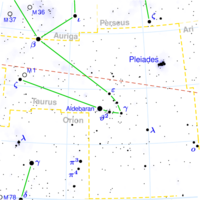Aldebaran
 From Conservapedia
From Conservapedia | Aldebaran | |
|---|---|

| |
| Observational Data | |
| Designation | Alpha Tauri AB HD 29139 HIP 21421 |
| Right ascension | α Tau A: 04h 35m 55.239s α Tau B: 04h 35m 57.0s |
| Declination | α Tau A: +16o 30′ 33.49″ α Tau B: +16o 30′ 22″ |
| Constellation | Taurus |
| Type of object | Binary star |
| Magnitude | α Tau A: Apparent Mag: 0.75-0.95 Absolute Mag: −0.63 α Tau B: Apparent Mag: +13.6 absolute Mag: 11.98 |
| Astrometry | |
| Distance from Earth | 65.1 ly |
| Radial velocity | 54.26 ±0.03 km/s |
| Proper motion | α Tau A: RA: 62.78 ±0.89 mas/yr Dec.: −189.35 ±0.58 α Tau B: RA: 64 ±25 mas/yr Dec.: -191 ±25 mas/yr |
| Parallax | 50.09 ± 0.95 mas |
Aldebaran, also called Alpha Tauri, is the brightest star of the constellation Taurus with an apparent magnitude of 0.87. The star is actually a binary pair consisting of a red giant and red dwarf, although only the giant Aldebaran A is visible to the unaided eye.
Contents
- 1 Aldebaran in Culture and History
- 2 Star System
- 2.1 Aldebaran A
- 2.2 Aldebaran B
- 2.3 Planetary System
- 3 References
Aldebaran in Culture and History[edit]
The name Aldebaran itself is from (الدبران al-dabarān), which translates as "the follower". It is believed this is in reference to the star "following" the Pleiades. The name was once given to the nearby open cluster of the Hyades, which Aldebaran was likely seen as part of due to its apparent proximity, despite the star being technically unrelated to the stars of the Hyades.
Ptolemy referred to the star as Λαμπαδίας, meaning "torch bearer"; it was also known in ancient Greece as Λαμπαύρας.
In Hindu astronomy, the star was known as Rohinī, meaning a red deer, likely due to the reddish-orange gow of the star. For the Chinese, it was called (畢宿五 Bìxiùwŭ), meaning "the Fifth Star of the Net".[1]
Star System[edit]
The Aldebaran system is located some 65.1 light years away. The two individual stars of the binary system orbit each other with a mean distance of 607 AU. It was once thought that a nearby binary pair made up of a K5 and M2 dwarf were also part of the system, but in reality they are an optical binary (stars that visually appear to be part of a system but are not actually gravitationally bound to it), located much further away from our Solar System. The primary, Aldebaran A, is thought to possibly have a gas giant in close orbit.
Because Aldebaran is located near the ecliptic, it is regularly occulted by the Moon near the time of the autumn equinox, with the next occurrence happening in 2015. It is this occultation that originally allowed for the accurate measurement of Aldebaran's size.[2]
Aldebaran A[edit]
The primary star, Aldebaran A, is a orange-red giant of spectral type K5 III. Before becoming a helium fusing giant star, it is believed that Aldebaran A was a class A spectral dwarf. It is estimated to have between 1 and 2.5 the mass of the Sun, with a diameter is around 43-44 times as great, enough to extend half way to the orbit of Mercury.[3] The surface temperature is a relatively cool 4010 K (the Sun in contrast has a surface temperature of 5780 K). Like all red giants, the star is highly luminous, with a total luminousity 425 times as great as the Sun, when accounting for the infrared.[4] The star's metallicity is estimated between 47 and 100 percent of our Sun's, based on the abundance of iron found.[5]
The star is a variable star, classified specifically as an irregular variable type LB. The variation of the star is small enough to be undetectable by human eyes, with an apparent magnitude change of only some 0.2 percent.[6]
Aldebaran B[edit]
The secondary star, Aldebaran B, is a red dwarf star of spectral type M2 V. If alone, the star would be far too dim to see from Earth in the night sky, as it has an apparent magnitude of only 13.6. The small star has around 15 percent of the Sun's mass and 3 percent of its diameter. As a dim red dwarf, the star only has .0014 of a percent of the Sun's luminosity.
Planetary System[edit]
In 1997, it was announced by astronomers that a planet was discovered in orbit around Aldebaran A via measurements of oscillations in the star's long term radial velocity.[7] The planet though has yet to be independently confirmed, with some astronomers being skeptical, believing that the variation in radical velocity is due to the long term oscillation of the star itself.
If the planet exists, it would orbit the giant Aldebaran A with an mean orbit of around 1.35 AUs, taking about 1.8 years or 654 days to complete. The orbit itself though is rather eccentric (e=0.182 ±0.065). Estimates put the minimum mass of the planet at 11 times that of Jupiter, because of this, it is quite possible that the planet is really a brown dwarf.
References[edit]
- ↑ http://penelope.uchicago.edu/Thayer/E/Gazetteer/Topics/astronomy/_Texts/secondary/ALLSTA/Taurus*.html
- ↑ http://adsabs.harvard.edu/full/1979AJ.....84..872W
- ↑ http://adsbit.harvard.edu/cgi-bin/nph-iarticle_query?bibcode=1993ApJ...413..339H&data_type=PDF_HIGH&type=PRINTER&ext=.pdf
- ↑ http://stars.astro.illinois.edu/sow/aldebaran.html
- ↑ http://adsbit.harvard.edu/cgi-bin/nph-iarticle_query?bibcode=1992A&AS...95..273C
- ↑ http://www.konkoly.hu/cgi-bin/IBVS?4480
- ↑ http://adsabs.harvard.edu/cgi-bin/nph-bib_query?bibcode=1998MNRAS.293..469H&db_key=AST&high=3769fd414921247
Categories: [Double Stars] [Astronomy]
↧ Download as ZWI file | Last modified: 02/18/2023 17:53:37 | 10 views
☰ Source: https://www.conservapedia.com/Aldebaran | License: CC BY-SA 3.0
 ZWI signed:
ZWI signed: KSF
KSF